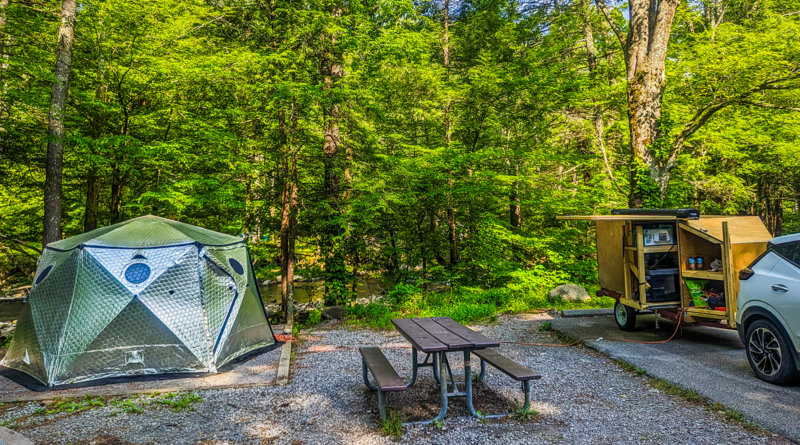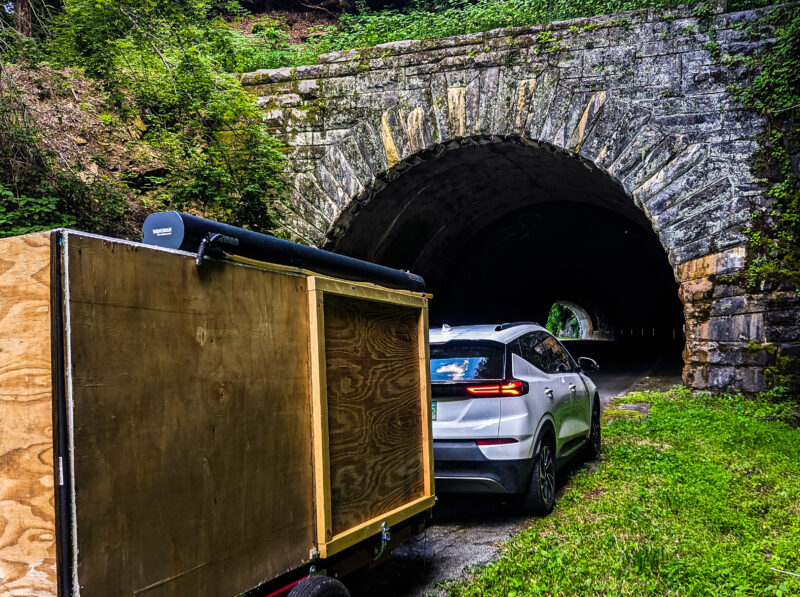My Bolt-Powered Glamping & E-Bike Trailer Setup (So Far)
Over the last couple of years, I’ve run several small fundraisers to build a better travel setup. The goal? To chase important clean technology stories, show people that affordable EVs can do the job (and are getting better), and to explore efficient trailer design. In this article, I’d like to summarize what I’ve done so far and where I plan to take the build next!
Last Year’s Initial Build
The whole build started with a used Harbor Freight trailer. I wanted a new one, but they simply weren’t available within 200 miles of me. One store 60 miles away confirmed that they had one on the phone, only for me to waste 2 hours driving there and back without buying one. But, the used one I found was next to new, and already put together, so that was a time saver.
The next step was to start adding a cargo box. To keep things efficient and easy to build, I built a box 4 feet wide, 4 feet tall, and 8 feet long. This required no plywood cuts (something I totally sucked at), and still gave enough room for a couple of bikes and camping gear. I put a ramp door on the back and a door on the side to make getting camping gear in and out easy.
Sadly, I had several things go wrong on the first trip. Stacking up all of the camping gear meant it was difficult and took a long time to unpack and repack everything. Worse, when things shifted around, an expensive portable refrigerator and a few other things got broken. So, I figured out that I needed some organization if I was going to make this trailer useful for serious travel.
Recent Upgrades & Improvements
So, this year (last year was kind of a bust for camping and travel for various reasons), I added a big drawer that slides out, both protecting the kitchen gear and making it easy to access at campgrounds, parking lots, and picnic areas!
But I needed a safe place to stash my Jackery 3000 Pro and my 1200 watts of folding solar panels, so I got my brother (who is much better with table saws than I am) to help me build a box on the front to both give me room for that and improve the trailer’s front aerodynamics a bit. On my most recent trip, I used the top part of the compartment for luggage because I wouldn’t be needing the solar.
To keep the Jackery 3000 Pro charged up going down the road and at campsites, I added what I’m calling “Amateur Power Onboard” (a play on Ford’s Pro Power Onboard). Basically, I wired up a 2000W pure sine wave inverter under the hood of the Bolt EUV and ran an extension cord along under the car to the hitch. There, I plug in a cord to the Jackery under the tongue box. The Jackery only pulls about 800 watts in “quiet mode,” so it doesn’t stress the car’s electronics.
I’ve found that the Jackery 3000 Pro is enough to power a heat pump or AC all night in the Shiftpod, along with things like phone charging, laptop, air mattress inflation, etc. So, I typically only run the inverter in the Bolt when it’s on and I’m driving. Typically, I do this during charging sessions so it doesn’t affect my range between them. But, if I wanted to power the campsite more from the car, I could put the car in neutral with the parking brake on and it would stay on all night (sadly, Bolts don’t have a utility or camping mode).
A Shakedown Cruise Revealed More Problems
I had planned on painting the exterior before leaving town, but ran out of time. This turned out to be a good thing, because had I slapped a coat of paint on it, I would have probably missed some gaps between the plywood and the frame that were letting water in. About the time I got to Arkansas, the weather let me know where all of the gaps were. Some severe thunderstorms passed through as I was visiting Hot Springs National Park, revealing every single place that water could penetrate. Sadly, some of these gaps were above my pillows.
The other problem I came across was that my doors just weren’t closing up very tight. This got worse as I progressed through rainy days in Tennessee and two of the boards warped, letting in pressurized water from the road. Fortunately, most of it didn’t get more than a few inches in from the doors.
Another big issue was the terrible tires Harbor Freight includes with its cheap (but structurally good) trailers. With only about 1700 miles of driving, the tires were getting pretty bald. I had a new spare tire, so I picked up another one from Harbor Freight, and was able to swap it out while I cooked pizza at Great Smoky Mountains National Park, just inside North Carolina.
When I arrived at some relatives’ house in North Carolina, it was sunny and dry, and I was able to make some improvements to the trailer. I dropped a bunch of additional screws where all of the gaps were, tightening them up. I then caulked up all of the seams on the trailer to make them watertight, added some weather stripping to the doors, and otherwise made sure the water would stay out.
Finally, I reinforced the outer edges of both side doors to prevent warping and redid all of the latches and hasps to keep the doors from coming open along the road again. The extra weight on the doors alone keeps them closed up more, but with some door bolts and the hasps being tighter, I’ve had no further issues with rain or wind opening them up along the way!
Sadly, as I’m headed back to New Mexico, the tires are becoming an issue again. After seeing a second properly-inflated set start to go bald, I did some reading and found out that the Harbor Freight tires are often badly put together at the factory. This means that I’m going to need to stop at a tire shop and get something better put on. So, if you decide to put your own trailer together on a Harbor Freight frame, be sure to upgrade the tires before going out on a road trip!
All images by Jennifer Sensiba.
Have a tip for CleanTechnica? Want to advertise? Want to suggest a guest for our CleanTech Talk podcast? Contact us here.
Latest CleanTechnica.TV Videos

CleanTechnica uses affiliate links. See our policy here.










